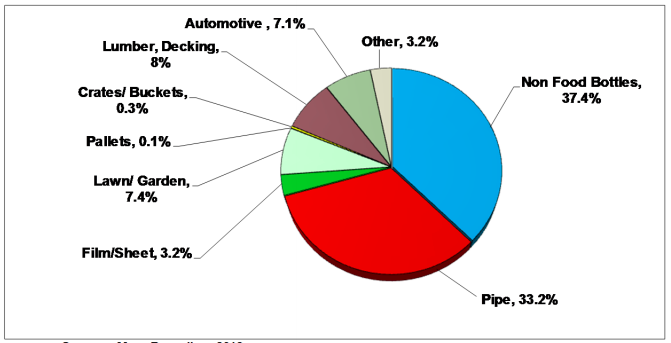As you might know, there are seven different types of plastic being used around the world - they differ in size, color, usage and disposal (if you didn’t know you can check our previous article where we explain the difference between these types). But, as a conscious (and curious) consumer, you might wonder: what types of plastic are recyclable? And what products can be obtained by recycling plastic? Well, if you are interested in discovering which plastic can be recycled and are curious about the second life of plastic waste, keep reading!
THE BARRIERS TO RECYCLING
In principle, almost all plastic can be recycled. However, in practice, there are a variety of different barriers that can undermine this process. Unfortunately, it does not always make environmental, economic, or technical sense to do so. Here are some reasons why recycling cannot always happen:
Many times, items can include multiple types of plastic and different layers which are hard to separate and make recyclability difficult and costly.
Plastics can often be contaminated by food and other substances, making the resins not clean enough to be reused.
Recycling facilities cost millions of dollars to build and operate can only be profitable when a huge amount of plastic is treated every day. Small quantities of plastics can therefore make recycling non-economical and non-beneficial, due to low efficiencies and high costs.
But don’t get discouraged! Despite these barriers, recycling still does happen and incredible products come out of this process. The majority of recycled plastic comes from post-consumer sources. This means that the milk jugs, bottles, packaging films that you throw away in the recycling bin, after undergoing the right process, will become post-consumer recycled material!
At Plastics for Change, for example, we use post-consumer recycled plastic to produce shampoo bottles, cosmetic caps, packaging films among other products. But let’s take this step by step.
WHICH PLASTIC CAN BE RECYCLED
1-PET
The most widely recycled plastic in the world is PET. Nonetheless, despite being a relatively easy plastic to recycle, some countries are still struggling to reach decent recycling rates. India, Europe and South Korea all have rates higher than 50% but countries like the US and China are yet to scale up those numbers.
The latest global statistics tell us that, in 2011, approximately 7.5 million tons of PET were collected worldwide. But what were they transformed into? Well, as crazy as it might seem, a substantial part of PET plastic (mostly found in plastic bottles) is usually recycled into fashion items! Among the items that can be obtained we find polar fleece clothes, backpacks, and carpets. That’s right, the plastic bottle you recycle today can become a cool t-shirt you will wear in a few months! Indeed, this recycling process involves transforming PET into flakes which can then be spun as a yarn. And these yarn are then used to manufacture clothes and other textile garments.
Alternatively, PET bottles can be recycled into... PET bottles! In fact, they are made of one of the few polymers that can be recycled into the same form – a new beverage bottle – again and again. During the process the PET is generally blended in a ratio of virgin to recycled, to give strength to the material for use in a new product.
A shampoo bottle made with clear recycled PET.
Finally, an innovative use of PET that is increasingly gaining momentum, is as a construction material in third-world countries. To create a building’s structure, plastic bottles are filled with sand, then stacked and either mudded or cemented together to form a wall.
A recycled house built by the Plastics For Change Foundation in Karnataka, India.
2-HDPE
HDPE is accepted at most recycling centers in the world, as it is one of the easiest plastic polymers to recycle. Recycling companies will usually collect HDPE products and send them to large facilities to be processed. In the US, the recycling rate for HDPE bottles is around 30%.
Just like PET, HDPE can be transparent or pigmented (colored). The primary markets of postconsumer recycled natural HDPE include non-food application bottles, such as for detergent, motor oil, household cleaners, etc. and film packaging. On the other hand, pigmented HDPE post-consumer recycled resin’s markets include pipe, lawn products, and non-food application bottles.
Oftentimes, HDPE is also downcycled (a recycling practice that involves materials’ reuse for lower-value products) into plastic lumber, tables, roadside curbs, benches and other durable plastic products.
US recycled HDPE bottle end uses (Source: More Recycling, 2018).
3-PVC
Unfortunately, plastic number 3, the so-called polyvinyl chloride is not recyclable in normal collections.
4-LDPE
Low-density polyethylene, also known as plastic-type #4, is used to make the infamous plastic bags like those provided by grocery stores and other retailers. Technically, LDPE can be recycled. However, as previously mentioned, just because something can be recycled doesn’t mean it will be recycled. Plastic bags, for example, tend to tangle in recycling machinery risking endangering the entire recycling process.
In addition, LDPE is a very cheap and low-quality plastic making its recycling not really financially worthwhile. As a consequence, many municipalities won’t accept #4 plastic in curbside recycling bins. Despite these difficulties, when recycled, LDPE can be transformed into bin liners and packaging films.
5-PP
The last plastic-type that can be recycled is PP also called polypropylene. While PP is easily among the most popular plastic packaging materials in the world, only around 1-3% is recycled in the US, which means most PP is headed for the landfill. Here it degrades slowly and takes around 20-30 years to completely decompose.
Again you may ask: “if it’s recyclable, why do we throw so much of it away?” And the answer, again, is that unfortunately, it doesn’t always make sense financially to reuse this material. Polypropylene recycling is difficult and expensive and, in many cases, it’s hard to get rid of the smell of the product this plastic contained in its first life. In addition, recycled PP usually ends up being black or grey, making it unsuitable for packaging use. For this reason, rPP is usually included in plastic lumbers, park benches, auto parts, speed bumps, and it’s used for other industrial applications.
6-PS (POLYSTYRENE) and 7-OTHER
Finally, plastics number 6 and 7 are never recycled.
FINAL CONSIDERATIONS
While in the past few years recycling rates have increased in almost every country, plastic recycling still has a long way to go to reach levels of reuse of materials such as aluminum and glass. Nonetheless, with a little contribution from everybody, recycling will hopefully become the preferred solution for plastic disposal.
At Plastics For Change, we offer high-quality rPET, rPP, rHDPE and rLDPE for brands and we are always striving to develop innovative solutions to treat even the hardest-to-recycle plastic and make good use of them!














